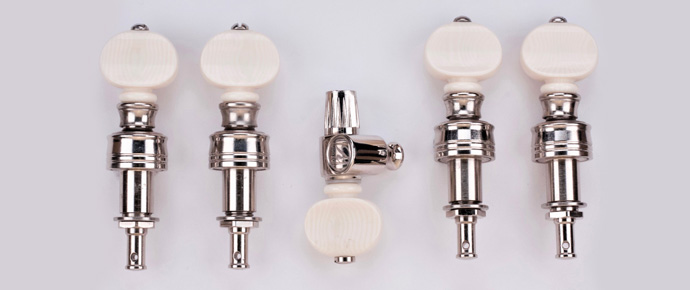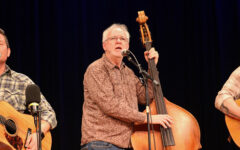
We recently received a set of the Rickard Cyclone 10:1 banjo tuners. Having heard very high praise of these tuning machines from both hobby and professional players, we reached out to Rickard and they graciously sent along a set for us to try out.
This is a premium product, with a retail price of roughly $225 for a set of five tuners, more than many banjo players would consider for replacement tuners. But given the advantages claimed by the manufacturer, Rickard Banjos in Toronto, they are something that discriminating banjo players and owners may want to put on their wish list.
The primary benefit these tuners offer is a 10:1 tuning ratio, as opposed to the more common 4:1 ratio used in most tuners. This means that instead of having to turn the button/shaft four times to complete one revolution of the tuning peg, it now takes ten. While that may sound like a bit of extra work – and it does feel like work when restringing – the final result is like having a set of fine tuners on your banjo, so making very minor adjustments in pitch are quite easy to accomplish.
But the most remarkable aspect of the cyclone tuners is how well they hold pitch. The cycloidal gear system they use makes it impossible for the tuner to backwind, unless you turn the button. In fact, when we spoke with Sean Sewell and Bill Rickard with the company today, they both mentioned that you can literally remove the button from the tuner shaft and it still won’t slip.
This is a function of the unique cycloidal device that Bill developed. Working for years in the conveyor systems business, he was well familiar with this type of gear mechanism, usually used with electric motors. In this design, there is an inner and an outer gear, and they are connected by an offset cam so that the inner and outer gears are not directly touching. With the Cyclone tuners, the inner gear supports the button shaft, and the outer gear the string post. The offset cam prevents the outer gear from turning backwards in response to string tension on the post, a common problem for banjo players.
Rickard told us that once he had the idea to try this, it took three solid years of experimentation to get it to function.
“I’ve worked for years in my family’s conveyor business, so I see these huge cycloidal drives all the time, like two feet high. The problem was getting it down to a small enough size for a tuner. These are usually attached to an electric motor, and the one shaft turns clockwise, and the other counter clockwise.
The trick was to get them going in the same direction. With an electric motor you can change the direction of the gears by changing the current direction. But ours is mechanical.”
Bill’s friend Frank Ford at Gryphon Strings in Palo Alto, CA had also experimented with this sort of system, but never could get the gears to move in the same direction.
“Frank kept telling me, ‘It will never work!’ But I kept at it. At least six times I nearly gave up, but always came back to it. When I finally got it to work, and sent one to Frank, he called and said, ‘How did you get this to work?!'”
Sewell, who is the production supervisor at Rickard Banjos, said that they first made a 4:1 tuner, and once they saw that it was working, moved on to develop the 10:1 set that they market as the Cyclone tuners. He told us that they didn’t design them specifically for the non-slip function, but it was a happy accident.
“We figured that it wouldn’t be able to backwind on its own. These are totally different from the planetary gears used for most straight through banjo tuners. You have to turn the inner gear to get the post to move backwards.
This could put an end to all the banjo tuning jokes!”
These tuners have been available since 2018, and all the machining is done in their Toronto facility. The only thing subbed out is the plating. This is also true for the many beautiful Rickard old time and resophonic banjos. They also source the walnut and cherry for the banjos from a local grower, giving a luthiery spin on the farm to table concept.
The tuners are offered with a variety of button types, from ivoroid and actual ivory, to boxwood, ebony, or plastic. A fifth string peg is also included with each set, but doesn’t use the cycloidal gear system.
So having described the Cyclone tuners, how they were designed, and how they function, just how well do they work in a practical application?
We installed them on an older Huber Lancaster banjo, replacing a set of Waverlys with Keith tuners on the second and third strings. The switch was quick and easy using only a crescent wrench. You notice right away just how compact the Cyclones are, and they are a good bit lighter in weight as well. A single metal pin pushes itself into the back of the headstock as you tighten the nut down at the tuning post, to ensure that the tuner doesn’t spin.
As mentioned earlier, the 10:1 ratio takes a bit of getting used to when restringing, but the ability to make those fine tuning adjustments with the peg means you won’t need to push on the string anymore, either behind the nut or down near the bridge, to nudge a string into tune.
Most remarkably, they really do hold tune just as predicted. Once you get the slack out of a new set of strings, these pegs simply don’t move. When putting on a capo, they strings stayed in tune, unless you tighten down too far with the capo screw. We even changed tunings – G to D, G to C – and the other strings didn’t move at all. This is often a stage nightmare for banjo players who don’t have a second banjo at the ready, and most just won’t use altered tunings given the time it takes the banjo to settle back in after changing tuning. I always thought that it was the change in tension overall that caused the tuning problems here, but these Cyclones didn’t move at all.
The throw of the tuners is extremely smooth and even, so much so that at first I feared that I would need to tighten the screw at the end of the shaft. But no, this smooth movement is the way the Cyclones tuners are meant to feel. If I hadn’t tried it, I wouldn’t have believed it.
We tried the same basic tests on an early ’60s Gibson RB-250, and got identical results.
We have to rate these tuners as first rate, excellent in every way.
We can’t finish this story without a mention of Bill Rickard’s amazing life story, and why he is such a determined inventor and tinkerer.
Starting at age 15, he developed a fascination with motorcycles, both building and riding them. Since his family operated a machine shop, he could make substitute parts on his own, and did so freely. A bit later he fell in love with bluegrass banjo, and spent the necessary time learning to play it himself.
Fast forward a good bit, and an adult Bill was working the family business, in Italy for a trade show in 2002, and took a ride on a Ducati bike that he was offered a chance to put through its paces. While zipping down the highway, a young truck driver fell asleep at the wheel, and drifted into Bill’s lane. Rickard’s bike hit the truck head-on, and he was flung up into the windshield and back onto the road. He lost both an arm and a leg in the accident, and had recently begun an interest in playing clawhammer banjo.
He told us that it was a rough road getting better, but there came a turning point that changed everything.
“I’m one of the luckiest people on the planet. I took a couple of years recovering, and decided to stop whining and do something. So I can’t play anymore. But there are a lot of things I can still do!”
Since banjo playing was out, he figured, “Why not start a banjo building business?” So this newfound energy was dedicated to Rickard Banjos, and ultimately these new cycloidal gear tuners.
Now at 75 years of age, Bill still has new projects in the works. Rickard has started building guitars, based on the Martin OM design, the ones that used straight through tuning pegs like banjos.
And he has an eye on a new guitar tuner system.
“I’m working now on a guitar tuner, using a double enveloping worm gear. This type gears are used in space ships. It’s a lot like the typical worm gear tuners, but using an hourglass-shaped worm.”
He also hinted at the possibility of building some bluegrass banjo models in the future.
Don’t bet against Bill Rickard. If he puts his mind to it, he’ll surely figure it out.
Full details on the Rickard Cyclone tuners can be found online.







